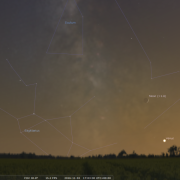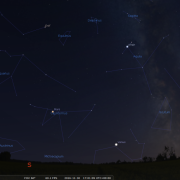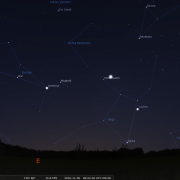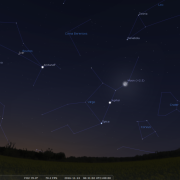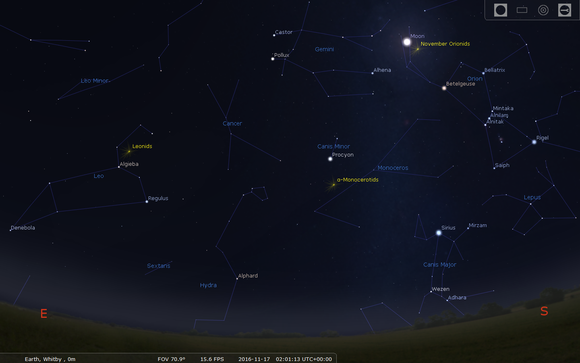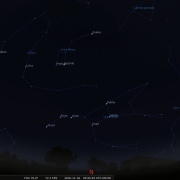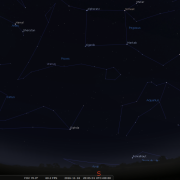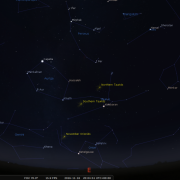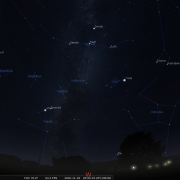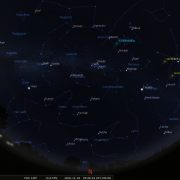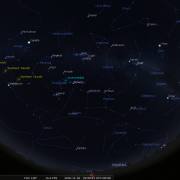In this month's Sky Notes:
Planetary Skylights

 As the November starts, look out for Saturn and Venus on the 2nd and 3rd very low in the SW sky approximately 40 minutes after sunset (around 17:00h) when a very young crescent moon lies above them. You will require an unobstructed horizon, but the view should be great.
As the November starts, look out for Saturn and Venus on the 2nd and 3rd very low in the SW sky approximately 40 minutes after sunset (around 17:00h) when a very young crescent moon lies above them. You will require an unobstructed horizon, but the view should be great.
By the second week in November Saturn is lost to twilight; however Venus remains above the SW horizon, seemingly moving parallel with it, before gradually climbing a little higher into the evening twilight. You cannot mistake Venus – it is exceedingly bright, though apart from noticing it has a phase (currently gibbous) little else will be visible due to the duvet of cloud which permanently shrouds the planet.
 Mars also continues to keep ahead of the evening twilight and is visible above the horizon in the SSW. A waxing moon lies above it on the 6th. Little is now distinguishable on the Martian disk.
Mars also continues to keep ahead of the evening twilight and is visible above the horizon in the SSW. A waxing moon lies above it on the 6th. Little is now distinguishable on the Martian disk.
 Conspicuous Jupiter is now emerging out of the morning twilight, visible by 05:00h low in the east. The moon les close by on the 25th. Speaking of which, the full moon on the 14th will be the closest of the year, a ‘supermoon’. It will appear slightly larger than normal, but certainly not as much as media hype will no doubt make out.
Conspicuous Jupiter is now emerging out of the morning twilight, visible by 05:00h low in the east. The moon les close by on the 25th. Speaking of which, the full moon on the 14th will be the closest of the year, a ‘supermoon’. It will appear slightly larger than normal, but certainly not as much as media hype will no doubt make out.
Meteor Showers

The Leonids are active from Nov 15-20, peaking this year in the early morning hours of Nov 18th. ZHR’s are expected to be normal, ie around 20 per hour, so an observer may expect to view around 7-12. The Leonids are of course famous for their 33-year (or so) periodic outbursts. This coincides with the orbital period of the showers parent comet - Temple Tuttle. The next major outburst is not expected until around 2031 at the earliest.
Keep an eye out for a few meteors on the night of Nov 4/5th when the South Taurid meteor shower reaches a peak, and then again on the night of Nov 11/12 when the North Taurid meteor shower peaks. This is a very long duration shower with a low rate of around 5 meteors per hour. The peak does not increase a great deal from this, however both Taurid showers span over a month so there is a good chance you will spot one or two.
Taurids may well be few, but they tend to produce the odd very bright fireball and therefore well worth keeping an eye out for. The Taurids are an old shower, associated with Comet Enke, which has a period of just 3.3 yrs. Over time dust from this comet has been depleted and spread out over a broad swath of the inner solar system, giving rise to Taurid meteor showers not only on Earth but also on Mars and Venus too!
November 2016 Sky Charts
Click each image to see a full-size Sky Chart:
|
Looking North
Mid-November - 20:00h |
Looking South |
|
Looking East
Mid-November - 20:00h |
Looking West
Mid-November - 20:00h |
|
Overview (Northern Aspect)
Mid-November - 20:00h |
Overview (Southern Aspect)
Mid-November - 20:00h |
Additional Image Credits:
- Planets and Comets where not otherwise mentioned: NASA
- Sky Charts: Stellarium Software
- Log in to post comments

